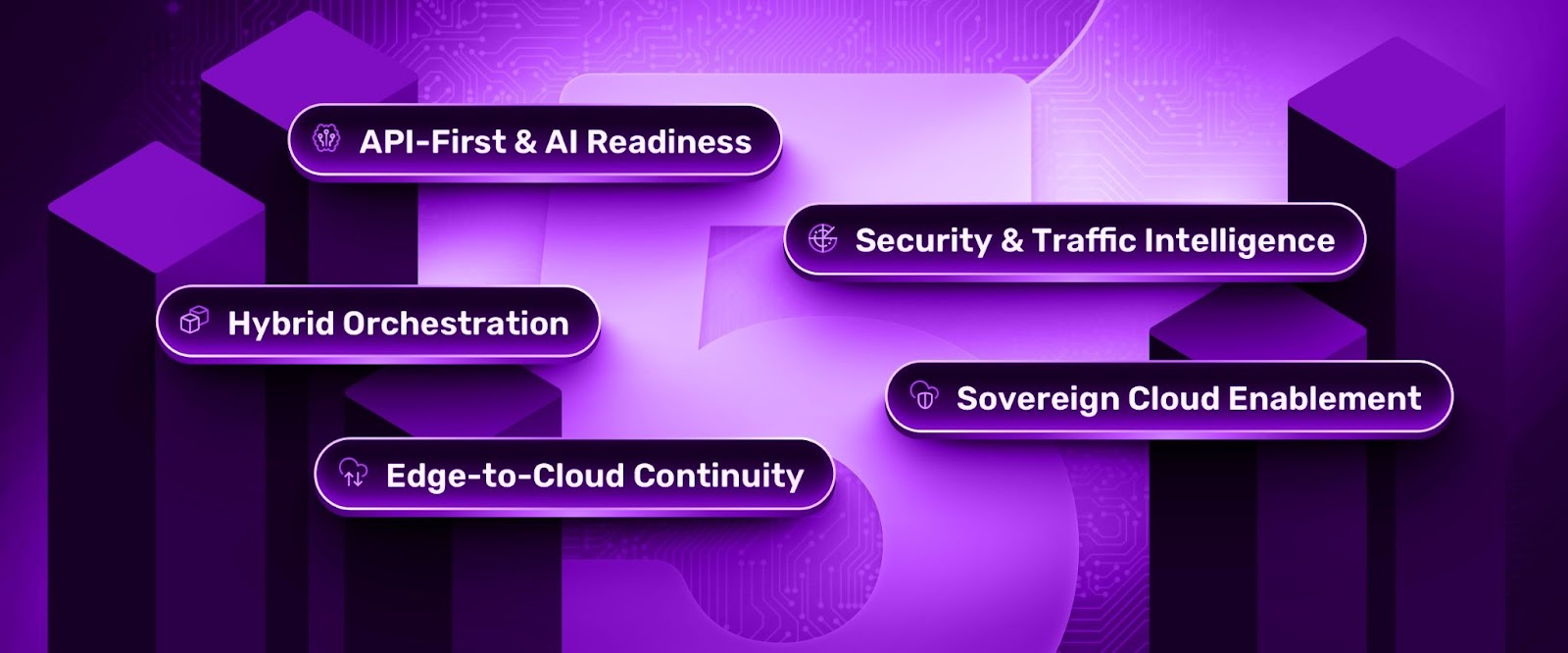The Application Intelligence Layer: Beyond Infrastructure to Intelligent Applications Everywhere

Three Landmark Reports Paint a Clear Picture of Infrastructure's Future
In recent months, three pivotal analyst reports have defined the trajectory of enterprise infrastructure:
- Gartner's Magic Quadrant for Container Management (2025) reveals that container platforms are reaching maturity, but application-layer capabilities remain fragmented
- Forrester's Wave™: Multicloud Container Platforms, Q3 2025 demonstrates that multicloud complexity demands unified governance and policy management
- Gartner's Distributed Hybrid Infrastructure (DHI), 2025 projects that 55% of enterprises will initiate DHI proofs of concept by 2028, driven by VMware disruption and sovereignty requirements
Together, these reports establish an undeniable consensus: the future is hybrid, multicloud, distributed, and demands application intelligence.
The catalysts driving this transformation are seismic. VMware licensing changes have created urgent migration pressures across enterprises. Sovereign cloud mandates are rewriting compliance playbooks. AI inferencing is pushing workloads closer to users and data. And the enduring reality highlighted across all three reports is that VMs and containers will coexist for years to come.
Infrastructure & Operations (I&O) leaders have already proven their capability—mastering Kubernetes adoption, driving modernization initiatives, and maintaining uptime in increasingly complex environments.
But as these reports make clear, the next critical challenge is emerging: How do we ensure that all this distributed infrastructure actually delivers resilient, secure, and intelligent applications everywhere?
What the Analysts Reveal: The Infrastructure Revolution Is Here
Reading these three reports together reveals a fundamental shift happening right now in enterprise infrastructure:
Container Orchestration Has Matured, But Application Delivery Hasn't
Gartner's Container Management Magic Quadrant shows that while Kubernetes and container platforms have achieved enterprise readiness, Layer 7 capabilities remain fragmented across vendors. Organizations are left stitching together ingress controllers, API gateways, and security tools.
Multicloud Success Requires Unified Application Governance
Forrester's multicloud analysis proves that the winners achieve policy consistency without vendor lock-in. But most organizations struggle with different authentication systems, inconsistent security policies, and fragmented observability across AWS, Azure, GCP, and sovereign clouds.
Distributed Hybrid Infrastructure (DHI) Adoption Is Exploding Due to VMware Disruption
Gartner's DHI research shows adoption expected to jump from 15% to 55% of enterprises by 2028—a once-in-a-decade transformation window. Organizations need cloud-native capabilities everywhere, but existing solutions force them to choose between infrastructure flexibility and application intelligence.
Edge and Sovereignty Are Strategic Imperatives
All three reports emphasize that latency-sensitive workloads, disconnected operations, and national sovereignty mandates are pushing infrastructure closer to users and under stricter jurisdictional control. Cloud-native principles must work without constant cloud connectivity and with complete data sovereignty.
The Hybrid Reality Demands Bridge-Building
All three reports acknowledge that virtual machines and containers will coexist for years. Yet most application delivery solutions work for one compute substrate or the other—not both seamlessly.
AI Workloads Need Immediate Governance
While not explicitly covered in these infrastructure reports, the elephant in the room is clear: AI inferencing is scaling faster than governance. Organizations deploying AI models across distributed infrastructure need consistent quotas, cost controls, and safety guardrails—not another complex tool to manage.
This convergence of analysis points to an undeniable conclusion: infrastructure has evolved, but application delivery is the bottleneck
The Solution: Modern Application Intelligence as a Unified Layer
The Application Intelligence Layer (AIL) is the missing infrastructure component that transforms fragmented application delivery into a unified, portable control fabric. Unlike point solutions that solve individual problems, modern AIL provides comprehensive application-aware capabilities that work consistently across any infrastructure.
This isn't just another tool—it's the connective tissue that transforms infrastructure investments into intelligent application delivery, regardless of where workloads run or how they're packaged.
For I&O leaders, AIL represents the natural evolution of infrastructure mastery, extending hard-won orchestration capabilities into the application layer where competitive advantage is ultimately determined.
The Five Pillars of Modern Application Intelligence

Traefik Labs has defined the essential capabilities that comprise a complete Application Intelligence Layer:
- API-First & AI Readiness: moves beyond basic load balancing to offer comprehensive API management, API Gateway, and AI Gateway capabilities like model routing, semantic caching, and safety guardrails.
- Security & Traffic Intelligence: delivers identity-aware routing (OIDC, mTLS), built-in WAF protection, intelligent traffic management, and end-to-end observability through OpenTelemetry.
- Hybrid Orchestration: provides unified policy management across both virtual machines and containers, with auto-discovery and support for gradual modernization patterns.
- Sovereign Cloud Enablement: ensures complete operational independence through zero external dependencies, offline policy bundles, and comprehensive audit-grade logging.
- Edge-to-Cloud Continuity: guarantees consistent behavior across distributed deployments with local gateway enforcement during connectivity failures and central policy management.
Application Intelligence in Action: Real-World Impact
Financial Services: Safe Hybrid Modernization
A global bank routes /v1/payments to VM-based core banking systems while /v2/payments serves containerized microservices—all with unified OIDC authentication and WAF protection. This enables safe, incremental modernization without the downtime risks that could cost millions per hour.
Healthcare: Sovereign PHI Protection
Hospitals manage patient data in air-gapped environments using offline policy bundles and signed attestation. Exportable audit evidence streamlines HIPAA compliance while maintaining complete operational independence from external systems.
Government: Multi-Jurisdiction Services
Agencies deliver citizen services with per-jurisdiction policy packs and complete data sovereignty. Zero external dependencies ensure compliance while tenant isolation maintains security across different government departments.
Manufacturing: Resilient Edge Operations
Factories rely on local Traefik gateways to enforce policies during WAN outages. Intelligent back-pressure prevents equipment failures while maintaining operational continuity during network disruptions.
AI Teams: Governed Model Deployment
Enterprises route inference traffic based on cost, latency, and data sensitivity. Semantic caching reduces redundant API calls by 25%, usage quotas control GPU spending, and safety filters ensure responsible AI deployment across all endpoints.
Each scenario demonstrates the same fundamental truth: application intelligence is what transforms infrastructure investments into competitive advantage.
The Business Case: Measurable ROI Through Risk Reduction
Application Intelligence Layer implementation delivers immediate, measurable returns through risk mitigation and operational efficiency:
Downtime Prevention: Even conservative estimates place enterprise downtime costs at $300K per hour. Preventing just a few hours of outages annually pays for AIL implementation many times over.
Compliance Assurance: Regulatory fines under GDPR, HIPAA, and other frameworks routinely exceed millions of dollars. Audit-grade evidence packs and consistent policy enforcement significantly reduce compliance risk.
AI Cost Control: GPU and LLM costs are escalating rapidly. Semantic caching and intelligent quota management can reduce AI infrastructure spending by 15-25%, often saving six figures annually.
Engineering Productivity: Teams spend 20-30% of their time managing configuration drift, static IP assignments, and firewall exceptions. Unified policy management reclaims this time for innovation.
Vendor Consolidation: By unifying WAF, ingress, API gateway, and observability functions, organizations reduce vendor sprawl and eliminate redundant licensing costs.
For I&O leaders, this isn't speculative ROI—it's embedded in avoided costs and operational efficiencies that every CFO immediately understands.
The Transformation Window Is Closing Fast
The convergence of analyst insights and market forces creates an urgent, limited-time opportunity:
VMware Migration Momentum: Gartner's DHI research directly links VMware disruption to accelerated infrastructure transformation. Organizations are already re-platforming—this strategic migration window won't reopen for years. Companies that integrate application intelligence now will avoid costly retrofitting later.
AI Governance Crisis Looming: While container and DHI platforms focus on infrastructure, AI workloads are scaling into production without proper governance. GPU costs are exploding, compliance risks are mounting, and the organizations that implement AI guardrails now will avoid the financial and regulatory crises facing late adopters.
Multicloud Complexity Compounding: Forrester's analysis shows that multicloud complexity increases exponentially without unified governance. Every month of delay makes consistent policy management exponentially harder to achieve.
The future-ready organizations identified across all three reports share one characteristic: they don't just migrate or orchestrate infrastructure—they transform it with application-aware intelligence from day one.
The Traefik Advantage: Completing the Stack
Traefik Labs uniquely positions enterprises for this transformation:
- Proven Integration: Native embedding in Rancher K3s, Nutanix NKP, and Nutanix AHV provides validated deployment paths
- Open Source Foundation: Millions of developers trust Traefik's core technology, with clear upgrade paths to enterprise governance features
- Platform Agnostic: Traefik enhances rather than replaces DHI and container platforms, extending their orchestration capabilities with application-layer intelligence
Traefik don't compete with your infrastructure investments—it completes them.
Act Now: Your Application Intelligence Foundation
The analyst consensus is clear, the market forces are aligned, and the technology is proven. The question isn't whether to add application intelligence to your infrastructure strategy—it's how quickly you can implement it to transform current investments into lasting competitive advantages.
Start with immediate validation. Choose the approach that fits your most pressing need:
5-Day Infrastructure Bridge Pilot: Deploy unified WAF protection, identity-aware routing, and observability across both VM and container workloads. Prove policy consistency and validate rollback procedures in a controlled environment.
AI Governance Quick Win: Add usage quotas, safety guardrails, and cost tracking to existing AI inference endpoints. Demonstrate immediate ROI while establishing governance patterns for enterprise scale.
Multicloud Policy Unification: Implement consistent authentication and security policies across two cloud environments. Validate the portable governance model that Forrester identifies as critical for multicloud success.
Sovereign Cloud Readiness Test: Deploy signed policy bundles in a disconnected environment and generate audit evidence packs. Prove operational independence capabilities for compliance requirements.
The transformation window identified by Gartner and Forrester is closing. Organizations that act decisively will establish application intelligence capabilities that become increasingly difficult for competitors to replicate.
Ready to evolve from "infrastructure anywhere" to "intelligent applications everywhere"?
Request your pilot and start build your application intelligence foundation now.




